

Popular North Korean Comedienne Sent to Work in Coal Mine Over Slip-up. Updated at 11:45 a.m.
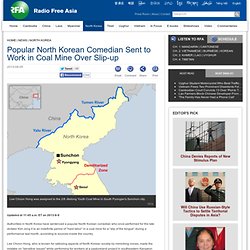
ET on 2013-8-9 Authorities in North Korea have sentenced a popular North Korean comedian who once performed for the late dictator Kim Jong Il to an indefinite period of “hard labor” in a coal mine for a “slip of the tongue” during a performance last month, according to sources inside the country. Lee Choon Hong, who is known for satirizing aspects of North Korean society by mimicking voices, made the mistake on "sensitive issues" while performing for workers at a pastureland project in southeastern Kangwon province, said a resident of the North who spoke to RFA’s Korean Service last week.
“Lee Choon Hong had a slip of the tongue while giving a performance for the workers at the Sepo reclamation project site,” the source said, speaking on condition of anonymity. “He was sent to the city of Sunchon in South Pyongan province to carry out reform work at the Jikdong Youth Coal Mine,” he said. Second assignment Reported by Young Jung for RFA’s Korean Service. Kwan-li-so: North Korean political penal labour colonies. Overview[edit] Estimates suggest that at the start of 2007, a total of six kwalliso camps were operating within the country.
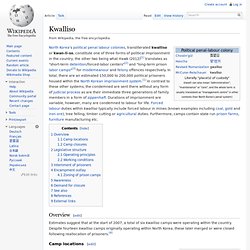
Despite fourteen kwalliso camps originally operating within North Korea, these later merged or were closed following reallocation of prisoners.[4] Camp locations[edit] Kwalliso locations in North Korea North Korea's kwalliso consist of a series of sprawling encampments measuring kilometers long and kilometers wide. The following lists the operating kwalliso camps: Camp 14: Kaechon internment Camp. Kaechon internment camp (Hangeul: 개천 제14호 관리소, also spelled Kae'chŏn or Gaecheon) is a forced labor camp in North Korea for political prisoners.
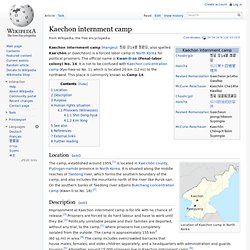
The official name is Kwan-li-so (Penal-labor colony) No. 14. It is not to be confused with Kaechon concentration camp (Kyo-hwa-so No. 1), which is located 20 km (12 mi) to the northwest. This place is commonly known as Camp 14. Camp 15: Yodok concentration camp. Yodok concentration camp (also romanized Yodŏk, Yodeok, or Yoduk) is a political prison camp in North Korea.
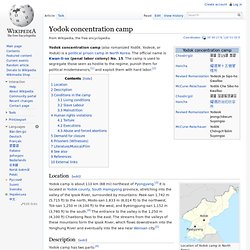
The official name is Kwan-li-so (penal labor colony) No. 15. The camp is used to segregate those seen as hostile to the regime, punish them for political misdemeanors,[1] and exploit them with hard labor.[2] Camp 16: Hwasong concentration camp. Camp 18: Pukchang concentration camp. Pukch'ang concentration camp (Hangeul: 북창 제18호 관리소, also spelled Bukchang) is a labor camp in North Korea for political prisoners.
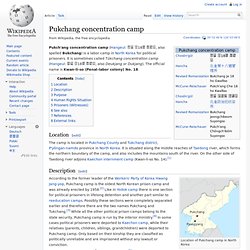
It is sometimes called Tŭkchang concentration camp (Hangeul: 득장 제18호 관리소, also Deukjang or Dukjang). The official name is Kwan-li-so (Penal-labor colony) No. 18. Location[edit] Camp 22: Hoeryong concentration camp. Hoeryong concentration camp (or Haengyong concentration camp) is a political prison camp in North Korea.
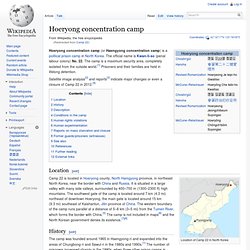
The official name is Kwan-li-so (penal labour colony) No. 22. The camp is a maximum security area, completely isolated from the outside world.[1] Prisoners and their families are held in lifelong detention. Satellite image analysis[2] and reports[3] indicate major changes or even a closure of Camp 22 in 2012.[4] Location[edit] No 25: Chongjin concentration camp. Chongjin concentration camp (Hangeul: 청진 제25호 관리소, also spelled Ch'ŏngjin) is a labor camp in North Korea for political prisoners.
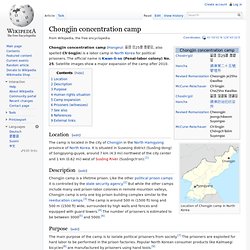
The official name is Kwan-li-so (Penal-labor colony) No. 25. Satellite images show a major expansion of the camp after 2010. Location[edit] The Hidden Gulag – Exposing Crimes against Humanity in North Korea’s Vast Prison System.pdf. Political Prison Camps in North Korea Today.pdf. North Korea’s Largest Concentration Camps on Google Earth. The Committee for Human Rights in North Korea estimates that North Korea holds approximately 120,000 people in its system of concentration and detention camps, and that 400,000 people have died in these camps from torture, starvation, disease, and execution.
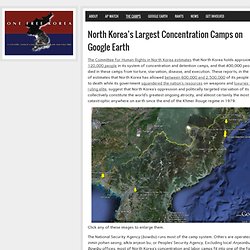
These reports, in the context of estimates that North Korea has allowed between 600,000 and 2,500,000 of its people to starve to death while its government squandered the nation’s resources on weapons and luxuries for its ruling elite, suggest that North Korea’s oppression and politically targeted starvation of its people collectively constitute the world’s greatest ongoing atrocity, and almost certainly the most catastrophic anywhere on earth since the end of the Khmer Rouge regime in 1979.
Click any of these images to enlarge them. The National Security Agency (bowibu) runs most of the camp system. Others are operated by the inmin pohan seong, a/k/a anjeon bu, or Peoples’ Security Agency. 1. This list is certainly not exclusive. Camps 14 and 18, North Korea: Satellite Imagery and Witness Accounts Part 1. In central North Korea, along the Taedong River far upstream from Pyongyang, lie two of North Korea’s five largest concentration camps: Camp 14 and Camp 18, which hold an approximate total of 50,000 political prisoners, their spouses, and their children.

The camps lie on opposite sides of the river in an area rich in coal, where mines are worked by the mine’s prisoners. For context, here are the boundaries of both camps in relation to the other largest camps — Camp 15, Camp 16, and Camp 22. You can enlarge these images to full size by clicking on them. Coordinates and eye altitudes appear on the bottom of each image. Closer in, we can determine the boundaries of both camps …. … and identify their main industries and population centers. The North Korean government denies that these camps even exist; however, survivor accounts continue to emerge to corroborate the horrors within these fence lines. The Prisoners. Camp 16 & Mt. Mantap Nuclear Test Site, Part 1. How do you tell a story that must be told, but still can’t be told?

Of all of North Korea’s largest political prison camps, the least is known about Camp 16, in this remote, mountainous corner of northeastern North Korea. Prisoners are never released from Camp 16, dead or alive. No witness has ever emerged to describe it first-hand. But if previous reports are accurate — really, they’re hardly more than accumulated rumors from nearby residents — one December night six years ago, Camp 16 was the scene of one of the most desperately courageous acts of defiance since the uprisings at Sobibor and Treblinka.
Five years ago, a start-up newspaper in Seoul staffed largely by North Korean refugees began to receive calls from its sources, who risked death to report the news from inside the world’s most closed society over smuggled Chinese cell phones. [Click images to expand] Most of those who escaped were probably caught. Camp 16 & Mt. Mantap Nuclear Test Site, Part 2. Start at Part 1 Who are the prisoners of Camp 16? They aren’t what we’d call criminals. In North Korea, criminals go to smaller labor-rehabilitation camps, from which eventual release is possible for those who survive the harsh and dangerous conditions. North Korea’s worst prisons — the vast death camps like Camp 16 — are reserved for people who haven’t committed anything we would recognize as a crime.
Prisoners are sent to the kwan-li-so for “committing” a variety of political crimes, or for being a relative within three generations of someone who has. This quote comes from a petition recently filed with the U.N. Camp 22: Holocaust Now - Looking Down Into Hell. From Prison Camp to Coal Hub. North Korea is trying to step up coal production at a former notorious political prison camp. North Korea is planning to convert a notorious political prison camp into a coal mining hub after transferring the remaining prisoners to another facility, according to sources.
The sources insist that Camp 22 in Hoeryong, North Hamgyong Province, was shut down as a detention facility between March and June after the prisoner population dwindled rapidly from 30,000 to 3,000 following a food shortage, despite an analysis of satellite images indicating that the facility may be continuing to operate. The remaining inmates from Camp 22 were moved south to another political prison—Camp 16—in Hwasong county in the same province, the sources said.
North Korean authorities meanwhile plan to exploit a large copper mine at the former prison camp following the closure of the nearby Kungsim coal mine. According to the source, the Kungsim coal stocks have been depleting since early 2000. Camp 25, Chongjin, North Korea. In October 2009, I was studying Google Earth imagery of the city of Chongjin in North Korea’s far Northeast, in awe of the acres upon acres of idled, rusted, collapsed factories, the ruins, and the sludge heaps. Around the same time, I was still reading the Korean Bar Association’s 2008 White Paper on Human Rights (KBA White Paper), for which I will always be grateful to the Voice of America’s Seoul correspondent, Kurt Achin. The report described a kwan-li-so, a political prison camp, of which images had never been published. That camp was also reported to be near the city of Chongjin.